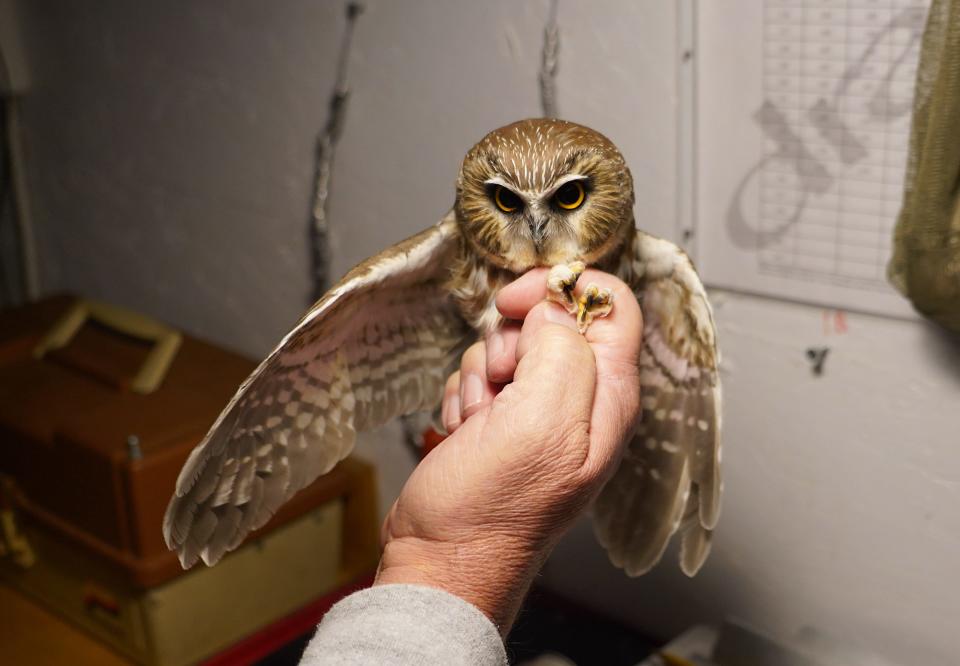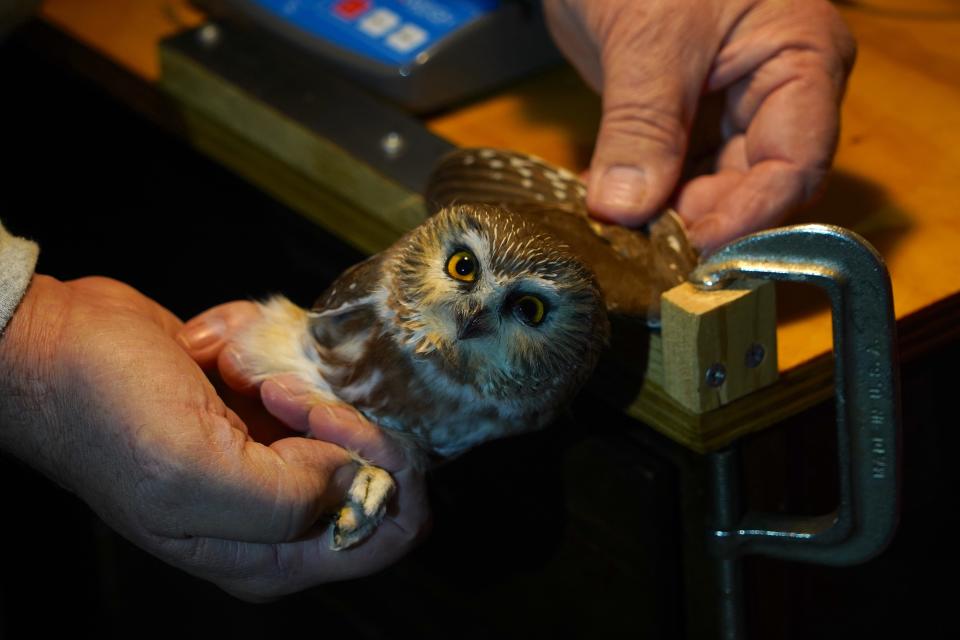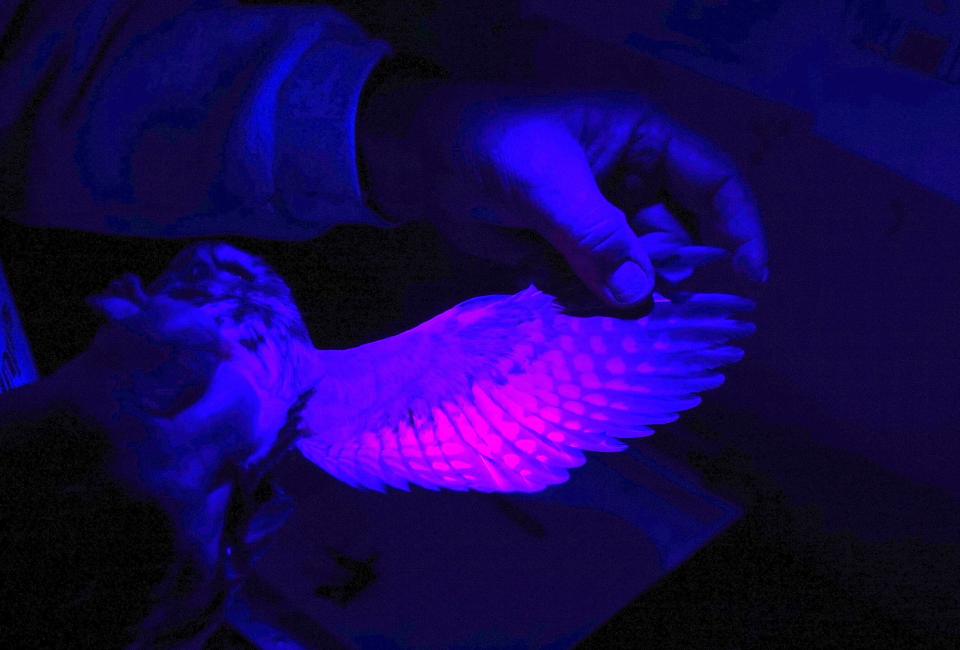Smith: Saw-whets, Wisconsin's smallest owl, are also little known and rarely seen

AMHERST - A high-pitched, staccato sound dominates the autumn night in a woodlot outside Amherst.
"What do you say we go check the nets?" says Dale Matheson of Amherst.
Matheson was polite to ask. But he knows Buzz Butters of Ripon and I are chomping at the bit to see what might be caught in the mist nets on his central Wisconsin property.
It's Oct. 28 and in parts of Wisconsin kids are setting out dressed in costumes hoping to collect Halloween treats.
Our group, outfitted with headlamps like miners, is also looking to strike it rich with a brief yet scientifically-valuable wildlife encounter.
Matheson leads the way down a leaf-covered path. His light pierces the darkness then focuses on a section of volleyball-like netting erected in the woods.
"Yep, we've got some," he says, reaching out to secure a feathered lump.
The object of our quest is the northern saw-whet owl, the smallest owl found in Wisconsin. And due to its reclusive, nocturnal habits, the saw-whet is likely our least known and most rarely seen owl.
Matheson is a licensed bird bander who works to trap, measure, band and release saw-whets each autumn.
To do so he sets out four 40-foot-long, 8-foot-high nets arranged in a cross and adjacent to an electronic caller. The caller is programmed with the vocalization of a saw-whet. The first set this night has captured three of the tiny owls.
Matheson immediately embarks on the delicate work of extricating the owls from the net. He uses a pencil to help guide the fine panels around the birds' wings and feet.
In a few minutes all three are free and he places them in mesh bags. Butters and I carry the precious cargo into the adjacent garage for processing.
With the radio broadcast of the Wisconsin Badgers football game playing in the background, Matheson carefully measures, weighs, ages and, if it doesn't already have one, places an aluminum band on each birds' leg.
The band carries a unique number and allows the bird to be identified if found. Banding information provides critical information on saw-whets and helps answer questions about where they breed, where they spend the winter and what travel corridors they prefer.
It takes just five minutes for each bird.
On close inspection the birds have immaculate feathers framing a round head as well as sharp beaks and razor-like talons. They weigh about 4 ounces, are about 7 inches long and have about 17 inch wingspans.
It's a tiny, yet ferocious, predator in the woods. Hunting almost exclusively after dark, saw-whets primarily prey on mice and other small rodents.
"They do a lot of good for the ecosystem," Matheson said. "But most people have never seen one and don't know they exist."
Matheson, 68, is retired after a career as a mechanic at a car dealership and as co-owner of a print shop.
He now devotes much of his time to bird banding, an avocation he started 40 years ago when he saw a note about a banding demo being offered at Hartman Creek State Park in Waupaca.
He was intrigued and attended the session. In a twist of serendipity, the event was run by licensed bander Bob Welch, who Matheson knew from his youth. The two were a year apart in school and both graduated from Waupaca High School.

Welch taught his former schoolmate a lot about birds and then asked Matheson if he wanted to get a permit to do bird banding.
Matheson accepted the invitation and received the required training and certification. He is listed as a subpermitee under Welch.
As such, Matheson is licensed to band all birds except waterfowl, eagles and threatened and endangered species. The permit is issued through the U.S. Geological Survey Bird Banding Laboratory.
He does most of his banding on songbirds during the spring migration. This spring he banded about 1,000 songbirds, Matheson said.
And much of his work is done on the property he and his wife own near Amherst. Land in the area has been in his family since Matheson's great-grandfather homesteaded here in 1892.
It's likely none of his ancestors had seen the relatively common but very small owl found in the Wisconsin woods they settled.
The Cornell Lab of Ornithology describes the saw-whet as having a "catlike face, oversized head, and bright yellow eyes" and "practically bursting with attitude."
Wisconsin is listed as year-round habitat for saw-whets. But in fall, Matheson said some birds also migrate through the state on their way to wintering grounds to the south.

The female saw-whet does all of the incubation and brooding, while the male does the hunting, according to the Cornell Lab. When the youngest nestling is about 18 days old, the female leaves the nest to roost elsewhere and provides no further assist to the brood.
The male continues bringing food, which the older nestlings may help feed to their younger siblings. The young owls develop very quickly and leave the nest in 10 to 14 days.
Though small, the saw-whet can migrate long distances, including across large expanses of water.
Its name may have come from its call that sounds like a saw being sharpened on a whetting stone; however ornithologists say there is no consensus on how it got its name.
Migration in saw-whets was poorly understood because of their nocturnal, reclusive behavior. But thanks to banders such as Matheson, as well as Project Owlnet, a collaboration started in the 1990s with more than 100 owl migration banding sites, much has been learned in recent decades.
It's now known, for example, that some saw-whets stay in a home range year-round and others migrate long distances, including across the Great Lakes. In October 1999, a saw-whet landed on a fishing vessel 70 miles from shore in the Atlantic Ocean near Montauk, New York, according to the Cornell Lab.
Matheson said a saw-whet was also captured in subsequent years in Massachusetts to Minnesota.
Data from Cedar Grove Ornithological Research Station in Ozaukee County highlights how common saw-whets are in Wisconsin. As of Oct. 31, staff at the station had handled 246 saw-whet owls this banding season, more than any other species.
Staff and volunteers at the facility trap, measure, band (if appropriate) and release birds, mostly raptors.
The top five species handled through October at CGORS were saw-whets (246), sharp-shinned hawks (236), red-tailed hawks (83), merlins (80) and Coopers hawks (24).
Our evening of banding outside Amherst produces a jackpot moment.
Among the seven owls caught in three checks of the nets over three hours, two already were wearing bands. As Matheson processes the birds he writes down the serial numbers on the aluminum rings and looks them up in a database.
One is a bird banded by Bob Welch, his mentor, 11 days earlier and 4 miles away. Matheson has previously caught other birds over the years banded by others in Wisconsin.
But the other banded saw-whet is a first in his career. It's a bird he banded in October 2021 on this same property.
In his 40 years of work, it's the only recapture of one of his own birds he's ever had.
The adult bird was about the same size and weight as it was two years prior. Saw-whets have been documented to live as long as 9 years in the wild.
Like all the birds, it was handled as quickly as possible and then taken outside and placed on a roost platform to fly off when it was ready.
When we checked on it 15 minutes later, it had left.
"Maybe we'll meet again," Matheson said. "I wish it happy hunting and safe travels."
Smith: With a change in leadership, the Urban Ecology Center remains in good hands
More: A new nonprofit aims to decrease the damage from wake boating on smaller Wisconsin lakes
This article originally appeared on Milwaukee Journal Sentinel: Saw-whets, Wisconsin's smallest owl, are also little known

